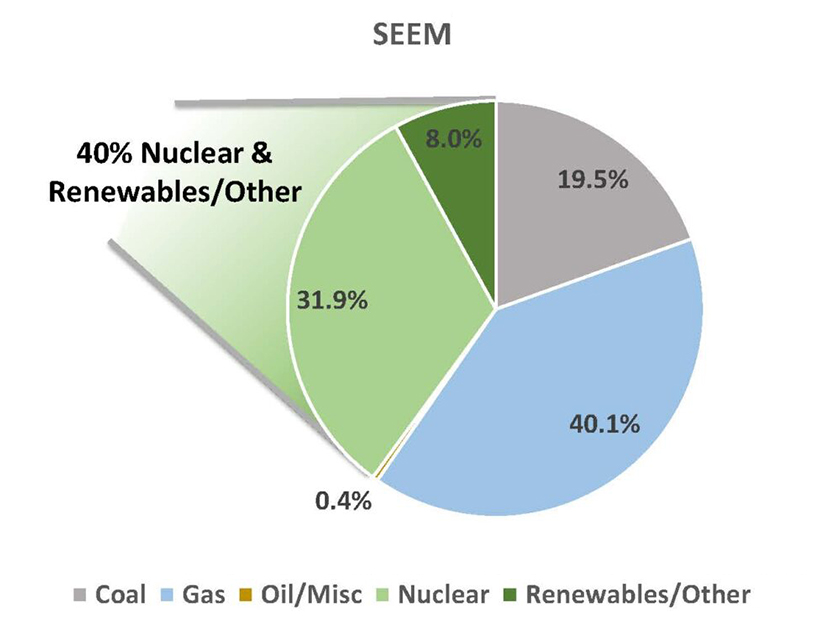Oral arguments on the appeal of FERC’s approval by operation of law of the Southeast Energy Exchange Market (SEEM) held Wednesday at the D.C. Circuit Court of Appeals focused on the issue of deadlines.
FERC deadlocked 2-2 in October 2021 over the lawfulness of the market, which makes available unused transmission capacity from its member utilities in the Southeast for additional trades among its members. Under the Federal Power Act, the tie meant that the commission approved the market, even though it did not issue an order on it.
The automatic approval drew rehearing requests, but FERC unanimously ruled that they were filed too late, coming 30 days after commissioners filed statements on their positions — instead of a few days earlier, when the SEEM agreement actually went into effect. (See FERC Rejects SEEM Opponents’ Rehearing Requests.)
The commission also later approved rules for SEEM in a separate order. (See FERC Accepts Key Tariff Revisions to SEEM.)
The case was appealed by environmental groups and renewable energy advocates, with Earthjustice attorney Danielle Fidler arguing that FERC was wrong to deny the rehearing requests because of lateness and had to come up with a justification for its action under the Federal Power Act.
Judge David Tatel asked whether the court would have to rule on the SEEM tariff itself if it rejected the agreement in the first place.
“If the SEEM agreement were invalidated, then that would make it more difficult to have the tariff go into effect,” Fidler said. “But as they are separate orders, those orders have to be addressed.”
Judge Neomi Rao asked whether it would make sense to remand the case to FERC if the court agrees that it miscalculated its rehearing deadlines and have the commission address the merits of the case. FERC issued its first order on the case before Commissioner Willie Phillips, now acting chair, joined. It is now back down to four members after Richard Glick left at the beginning of the year.
Fidler said that because FERC based its approval of the SEEM rules on questionable claims, both orders needed to be remanded to the commission. Among those is that the SEEM market is “bilateral” when it crosses 10 states and matches up available transmission capacity with power sales based on an algorithm, she argued.
“The petitioners argue that that that decision is also arbitrary and capricious, and that information needs to be provided to the commission as it considers both the agreement and the tariff,” Fidler said.
The Federal Power Act was amended in 2018 to add Section 205g after FERC split on approving the results of ISO-NE’s Forward Capacity Auction 8. The new section stipulates that, in the case of a deadlock, the commissioners must explain their positions and that the courts are allowed to review such cases.
Rao admitted that the legislative history indicated Congress wanted the court to review cases such as SEEM, but she said the text of section meant it did not apply.
“The only thing that’s judicially reviewable under ‘g’ is if there is a deadlocked rehearing order; that becomes judicially reviewable,” Rao said. “But we don’t have a deadlocked rehearing order here. Here we have a rehearing order focused on timeliness.”
Petitioners have asked the court to review whether FERC was right on the timing of their rehearing requests, Fidler said. If they win that argument, she argued, then it would fall back to the automatic approval. The court would also be within its rights to provide guidance to FERC on remand, she added.
FERC Senior Attorney Robert M. Kennedy defended the commission’s rehearing order, saying that it correctly interpreted the notice period under 205g as the D.C. Circuit directed it to do in another case.
Rao asked how that decision fits in with in FERC’s own rules on deadlines, which go back decades.
“The commission has consistently taken the position that while that rule can be applied to deadlines for filers, it cannot be applied to the commission’s implicit statutory period to act on rate filings because that would impermissibly extend the burden, the waiting period, imposed on utilities by Congress,” Kennedy said.
In some emergency situations, FERC can take more time to rule on rates, but generally it tries to get orders out before the 60-day deadline and will issue orders earlier if the deadline falls on a holiday or weekend.
Section 205g holds that the failure to act constitutes an order. When FERC issued a notice on Oct. 13, 2021, about the case, it indicated that its failure to act happened on Oct. 11; that date set the rehearing deadline, Kennedy said. The petitioners misread the statute, and FERC was clear that its failure to act occurred on Oct. 11, he argued.
Rao asked Kennedy whether it would make sense for the court to just remand the case, requiring the commission to deal with its arguments.
That would be the standard procedure, Kennedy replied.
“What makes this case different, among many other things, is the fact that you have before you majority-voted orders from the commission that deal with many of the same issues that were raised with respect to the agreement,” Kennedy said.



